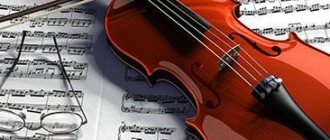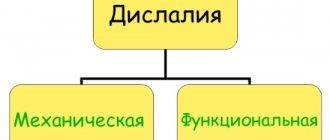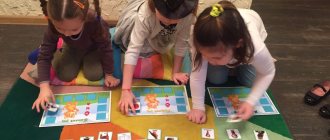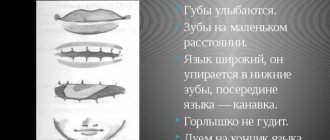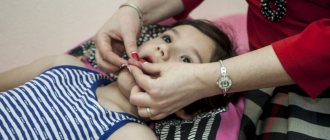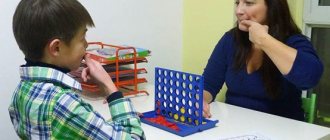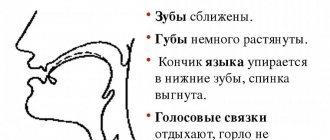The sound [zh] belongs to the group of hissing sounds and is a voiced version of [sh], so you need to start the production with [sh]. In most cases, teaching a child to say the letter Z is not very difficult, although it is not easy in its articulation and is not always immediately given to children. This requires regular exercise, patience and the mutual desire of the child and the adult.
Speech hearing
Correct speech of a child is achieved through speech hearing. To pronounce sounds correctly, the child must clearly perceive them by ear.
Determine the location of sounds in a word: at the beginning, middle or end of the word. Hear whether a given sound is hissing or not.
Distinguish sounds against the background of similar sounds:
- In an isolated position
- In syllables
- In words
Expert opinion
Margarita Sergeevna S.
Speech pathologist and speech pathologist with 15 years of experience working in various speech correction centers with children of different ages.
With dysarthria, the production and automation of hissing sounds becomes more complicated and requires more time and individual training.
How to teach a child to pronounce sounds at home? Exercises for training complex sounds
The child celebrated his fifth birthday. He has been chirping a lot for a long time, but still does not know how to pronounce many letters, and he distorts words so that only close people can understand him. This problem is familiar to many parents and they all ask one question: how to teach a child to pronounce letters?
A child’s speech develops throughout preschool age. It is necessary to monitor it from an early age, so that by the first grade the child’s correct pronunciation of letters is fully established. But it happens that school-age children have unclean speech.
Sound pronunciation disorders
It is more effective to diagnose and carry out correction of speech disorders in preschoolers.
So that when entering grade 1, a child can clearly pronounce all the sounds of his native language, know their characteristics (hard or soft, voiceless or voiced, stressed or unstressed, paired or unpaired).
Classes for children are conducted in a playful way, step by step, from simple to complex - setting an isolated sound, introducing it into speech in syllables, words, phrases, sentences, text.
In secondary groups of preschool educational institutions, rapid diagnostics are carried out.
In the senior and preparatory groups there are subgroup and individual lessons.
Reasons why a child may not pronounce letters
Incorrect pronunciation of letters may be due to improper upbringing. If parents, when communicating with their child, change their voice, lisp or babble, then the baby gets used to such communication and his incorrect pronunciation of letters is reinforced.
Therefore, you need to speak to your child in correct and clear language. Immediately stop the slightest shortcomings in your baby’s speech, because with age it will be several times more difficult to correct them.
Wrong attitude towards spoken language. There is an opinion that learning to speak occurs without intervention from adults. But if parents do not participate in the process of developing the child’s speech, then over time the child’s lag in speech development will begin to appear.
Setting the sound
With normal speech development, “hissing” sounds, which include [Ш], [Ж], [Ч], [Ш], should appear in the child’s speech by the age of 4-4.5 years.
[Zh] is a consonant, always hard, sonorous sound of the Russian language.
There are several ways to achieve the result:
- With mechanical assistance
- By showing articulation
- From correct [R]
The use of one or more methods in combination depends on each specific situation.
To solve our problem, it is necessary to perform an appropriate set of articulation and breathing exercises every day.
Don't miss: Sound Sh
Breathing exercises
- "Swing". Take a lying position on your back. One hand is on the stomach and the other on the chest. When you inhale through your nose, your stomach rises; when you exhale through your mouth, your stomach lowers.
Exercise "Swing"
- "Bullets." Fill any small container (mug, glass, small jug) with clean water. Take a cocktail straw. Through it you need to exhale air into the water. Bubbles bursting out with a loud noise will turn the execution into an exciting game.
- "Singing". The vowels [A], [O], [U], [Y] must be sung when answering the question asked. How do the animals moan that came to Dr. Aibolit? "O-O-O-O-O." How does a snow blizzard howl in winter? “U-U-U-U-U-U.” How does the train hum when it sets off? “Y-Y-Y-Y-Y.” How naughty is a baby? "A-A-A-A-A." These chants must be pronounced as long as possible, but with one exhalation.
Articulation gymnastics exercises
- "Fence". Without opening your teeth, smile broadly. Do not strain your facial muscles. Try to hold a smile for 10-15 seconds.
- "Tube". Closed teeth are the main condition. Invite the child to reach out and take a nearby berry with his lips. If performed correctly and repeatedly, the lips will form a “tube”.
- "Broad language" The lips are open, we stick our tongue out of the mouth, and spank it with our lips several times until it becomes wide. We hold it in this position for 10-15 seconds. We calculate the time out loud.
Exercise "Scapula"
- "Shovel". The task is a continuation of the previous one. We place a wide, calm tongue, which we have already learned how to do, on the lower lip. The facial muscles are as relaxed as possible. Hold for 10-15 seconds.
- "Ball Throw" Make a small ball from a piece of cotton wool. Position the tongue as in the “Shovel” exercise. Bring your face closer to the ball and blow on it, trying to “throw” it as far as possible. When performing the task correctly, a distinct [F] should be heard.
- "Nitting." Open your mouth slightly. Slowly stick out your tongue and slowly bite it. Repeat the process several times, sticking your tongue forward and retracting it back. Perform with a smile, tensing your muscles. By saying something rhythmic, the child not only makes the task easier, but also becomes interested in it.
- "Cup". Open your lips and stick your tongue out. Try to bend it into the shape of a cup. It is recommended to perform in front of a mirror.
Don't miss: Dyslexia - what is this diagnosis?
- "Ladder". A more complex version of "Cup". We stick out our tongue and give it the appropriate shape. Raise it to your upper lip and hold it for a few seconds. We transfer to the upper teeth. We hold again. We translate, as if on a “ladder,” for them. We hold. We perform the process in reverse order. We repeat several such descents and ascents.
- "We got dirty with ice cream." Without helping with the lower lip, but only with one tongue, lick the upper lip with a vertical movement (from the nose down). The child must imagine that she has soiled herself with something tasty. For example, ice cream.
- “Brushing our teeth.” We smile and open our mouth wide. The teeth should be clearly visible. We begin to move the tip of the tongue from the inside, first along the upper teeth several times, then along the lower ones. The movements should resemble those of a toothbrush. Try not to move your lower jaw.
Exercise “Brushing your teeth”
- "Ball on the nose." Let's prepare a small ball of cotton wool. We open our mouth slightly. We lightly press the protruding tip of the tongue to the upper lip. By blowing air between your tongue and lip, we try to blow the ball off your nose. The flow should be directed upward.
- "Let's draw." We open our mouth wide, trying to smile. We begin to slowly stroke the palate with the tip of our tongue. The movements should resemble an artist's brush.
- "Mushroom leg" Open your mouth wide. We stick our tongue to the palate. The hypoglossal ligament stretches like a mushroom stalk. Hold this way for several seconds.
- "Umbrella". Let's complicate the previous exercise. Holding your tongue, we close and open your lips, as if opening an umbrella. We repeat several times, trying to open our “umbrella” as wide as possible. The exercise is aimed at stretching the hypoglossal ligament.
- "Buzzing." "Cup" of the tongue inside the mouth. Pull the lips forward a little and round them. The tip of the tongue is to the palate, the edges are pressed against the upper lateral teeth. When trying to pronounce a buzz, the throat begins to tremble.
Speech material for sound automation
Syllables (example):
We take individual syllables - zha, zho, zhe, zhi, zhu. We pronounce them separately several times, as clearly as possible. We make a design of two - zha-zhu, zhu-zhe, zhu-zhu and others. We pronounce it. We complicate it to three - zha-zho-zha, zhu-zho-zha, zhu-zhi-zha.
Don't miss: The easiest ways to make the sound H
The exercise is not about speed, but about clear pronunciation.
Words (example):
We pronounce words and phrases - yellow, live, ice cream, shortbread, live toad, leather jacket and others.
Poems and rhyme (example):
By coming up with a rhyme, we introduce creative subtext into the lesson, which quickly consolidates the previously achieved result.
Prickly - yellow, simpleton - jacket, sea - alive.
Pure sayings (example):
They not only automate the result, but also make the child’s speech clearer in general.
The wife feels sorry for the toad, the yellow yolk fell on the jacket, the heat in the oven is frying hot.
Suggestions (example):
You need to come up with a short sentence for certain words. Additionally, they develop the creative component of the child’s speech.
The yellow leaf circles easily. The boots are very tight.
Examples of homework to reinforce the assignment.
Task No. 1.
Do breathing and articulation exercises for 15-20 minutes every day.
Task No. 2.
Correct pronunciation, complicating the process.
- Hedgehog. Hedgehog - don't touch it. There’s a prickly hedgehog sitting here, don’t touch it with your hand.
- Blazer. The jacket is a simpleton. Whoever put on such a jacket is very fashionable, not a simpleton.
- Buzzing. It buzzes and flies. The bee buzzes and flies home.
Task No. 3.
Perceive by ear. Connect in pairs and, adding a few words, come up with and write down a small sentence. You can simplify the task by offering several cards and the necessary terms or pictures.
Task No. 4.
We clap our hands for each syllable in the spoken words. Ear training exercise.
Yellow, jacket, ice cream, shortbread, buzzing, pulp, toad, life, plaintively, iron, rust.
Secrets to help quickly teach your child to pronounce letters
In addition to direct exercises with the child’s speech muscles and exercises to teach complex letters, it is necessary to pay attention to the development of fine motor skills. Together with your child, sort out the cereals, string beads on a string, and sculpt them from plasticine or dough. And most importantly: while working, do not be silent. Tell your child fairy tales, nursery rhymes or tongue twisters.
Another secret is to teach your child to repeat the letter “D” often. By pronouncing this magic letter, the muscles of the tongue are trained, it is positioned correctly in the mouth, and with constant training, the child will learn to pronounce the complex letter “r”.
When should parents sound the alarm and contact a speech therapist?
If a child cannot master the pronunciation of sounds for a long time, it is necessary to seek help from a speech therapist. Since there are cases when the inability to pronounce certain letters is explained by the physiological characteristics of the child. Thus, an incorrect bite can cause burr or lisp. In such situations, the doctor may prescribe special exercises or surgery, depending on the cause of speech difficulties. Also, a speech therapist as a professional can find other reasons for poor pronunciation and work with them on a more serious level than parents.
What about K and G?
The sounds K, G and X belong to the back of the tongue, which implies a high rise of the tongue when pronouncing them. When a child does not pronounce these letters, most often his tongue is simply lazy (with the exception of congenital pathologies that only doctors can correct). To make your tongue work, you need to do exercises.
Downhill skating . Place a cotton ball on your baby's palm. The baby should open his mouth slightly, hold the root of his tongue in a raised position, and lower the tip of it. Then you need to quickly exhale so as to blow the cotton wool from your palm. The sound will be K.
Spoon . Ask your baby to say “ta-ta-ta” slowly. Take a teaspoon and gently move your tongue away by pressing on the front of the back of it. Instead of “ta”, the baby will first get “cha”, and then “kya”. Continuing to press on the tongue, catch the moment when the baby produces a clean “ka.” He needs to remember what position his tongue was in at that moment. Don't worry if it doesn't work out right away.
Pronouncing the letters Z, S and C correctly
When a child does not pronounce the letter S, at the same time he cannot pronounce the other whistling letters and syllables - Z, Ts, Зь, Сь. The reason for this is an underdeveloped articulatory apparatus.
Special exercises will also help correct the situation.
- Drive the ball into the goal . The purpose of this task is to learn how to release a long, directed stream of air. Make gates on the table using blocks or other toys. Roll a loose cotton ball. The kid must, with his lips folded into a tube, blow on the ball and drive it into the gate. While performing the exercise, you should not puff out your cheeks, and the blown air should flow in one long stream, without interruption.
- Song of the tongue . With your mouth slightly open, you need to place your tongue on your lower lip. Then you need to spank with your sponges - “five-five-five” (the tongue sings). The air comes out in a smooth stream without interruption. Then, opening your mouth wide, hold the soft tongue on your lower lip so that it does not curl up. It is necessary that the edges of the tongue touch the corners of the mouth.
- Pancake . It is important to teach your baby to relax his tongue. To do this, he must smile and place the leading edge of his tongue on his lower lip. The smile should not be tense, and the tongue should only hang slightly from the lip.
- We brush our teeth . The exercise is similar to the task for the letter P, only we will brush the lower teeth rather than the upper ones.
The letter Z is paired with the letter C, so its production is done in the same way as the sound C.
